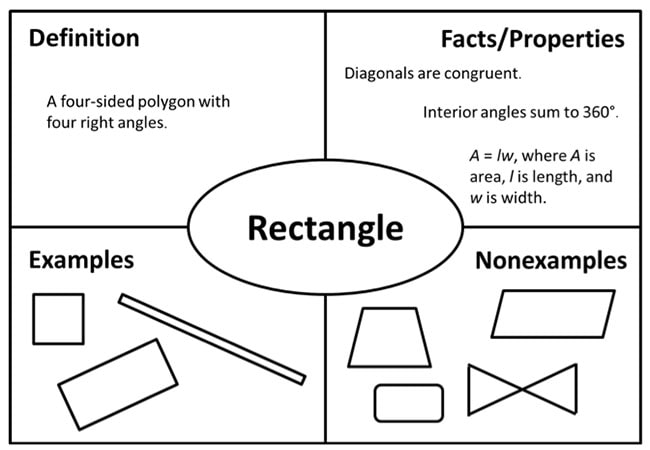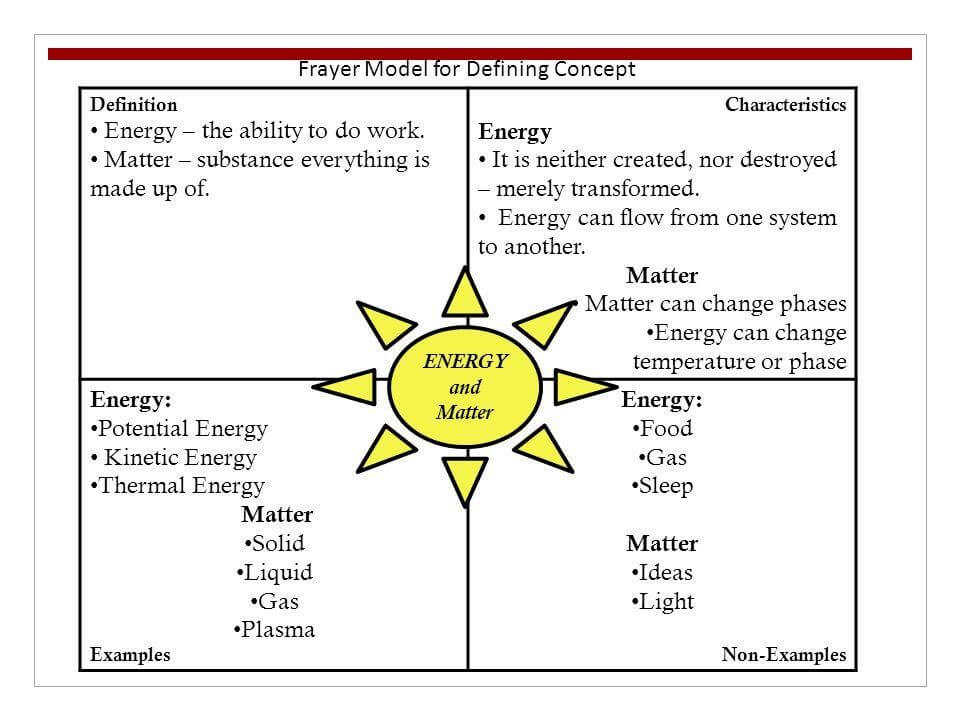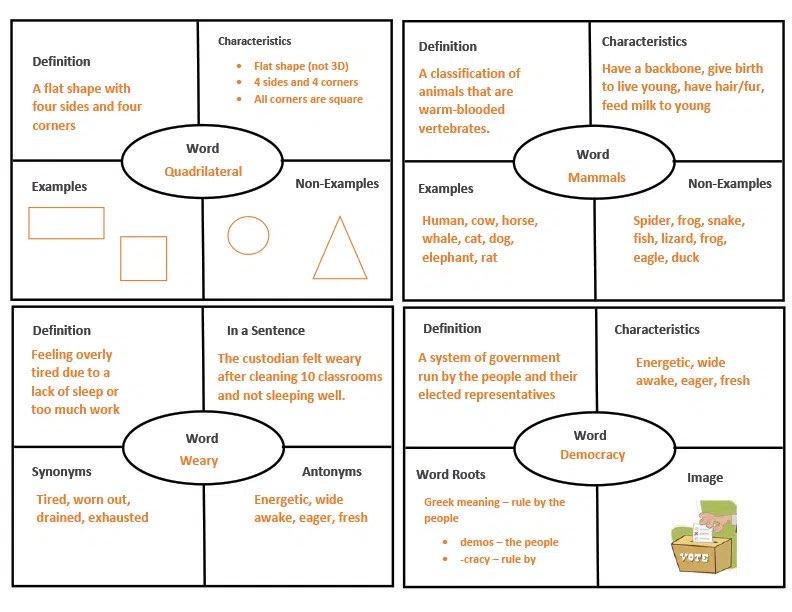The Frayer Model: Building Vocabulary Understanding
Complete 2025 guide to the Frayer Model vocabulary strategy. Free graphic organiser for definitions, characteristics, examples and non-examples. Digital tools and implementation tips.


Complete 2025 guide to the Frayer Model vocabulary strategy. Free graphic organiser for definitions, characteristics, examples and non-examples. Digital tools and implementation tips.
The Frayer Model is a graphic organiser used for word analysis and vocabulary building. This visual representation of concepts is a powerful learning tool, especially beneficial for visual learners, as it helps develop a comprehensive understanding of vocabulary. Originating from social studies education, it's now widely applied across subjects.
At its core, the Frayer Model consists of a square divided into four smaller sections, with the term or concept placed in the centre. Each section serves a distinct purpose: providing a basic definition, listing key characteristics, giving examples, and noting non-examples.
This structure prompts learners to explore and establish relationships between concepts, facilitating deeper engagement with the material.
For teachers, this method serves to reinforce students' background knowledge and clarify unfamiliar vocabulary. It moves beyond rote learning and dictionary definitions, encouraging students to think critically about the words and terms they're learning. By breaking down understanding into digestible parts, the Frayer Model helps students not only remember terms but also understand their application and relevance.
Throughout this article, we'll explore the who, what, where, and why of the Frayer Model. We'll provide practical classroom examples and discuss its historical development. The aim is to equip educators with a thorough grasp of how this strategy can enhance vocabulary development and concept understanding in the classroom.
The Frayer Model was created in 1969 by Dorothy Frayer and her colleagues at the Wisconsin Center for Education Research. Their main purpose was to help students meet academic vocabulary demands and learn difficult vocabulary more effectively. Dorothy and her team designed the model to support understanding of key vocabulary through explicit instruction and comprehensive word analysis.
Elements of vocabulary instruction such as structure, context, and metaphor are all part of the Frayer Model. It promotes effective word learning through scaffolding, meaning students receive guided practice as they move from a narrow understanding to full mastery. The model also applies Bloom's Taxonomy to develop deep understanding, encouraging reflective inquiry and creativity.
This visual approach to teaching is considered a powerful tool for instructing subject-area vocabulary and crucial concepts. The Frayer Model encourages students to learn abstract concepts through concrete examples, allowing them to construct their own understandings so the information can be applied to everyday life. It works for any problem solving situation.
If you're interested in using more graphical methods for teaching vocabulary and developing deeper understanding, you can explore the various organisers available in our repository. As well as providing a scaffold for students to learn with, they can serve as a springboard towards clearer thinking and writing.
The Frayer Model includes a four-square chart that provides academic vocabulary knowledge, while clarifying, determining, and analysing difficult vocabulary, word structure and meaning. The central oval has the chosen word written on it. In some cases, parts of speech can also be written in the central oval.
The Frayer Model is a graphic organiser used to help students learn new academic terms. It includes four squares that represent a word's characteristics, definition, examples, and non-examples. This tool allows learners to gain better understanding of difficult words through clarification and analysis.
The model works by having the chosen word written in the centre of an oval. Within each of the four squares surrounding it, associated concepts can be written down. The first square is for characteristics; this includes defining attributes such as sizes, shapes, and functions.
The second box is for the definition; this is usually expressed in one sentence and should cover the general meaning of the word or term being studied. The third box holds an example provided to give context around what can be expected from the given concept or term being assessed.
In the fourth box there's a listing of related non-examples; here you write down items that are related but don't fit into the current definition as presented by either characteristics or examples found in other squares, ruling them out altogether.

By integrating the Frayer Model into instructional strategies, teachers can enhance students' comprehension of subject-specific vocabulary, deepen their understanding of concepts, and promote critical thinking and collaboration within the classroom.


The students read the list and then write more examples to the first list and highlight those that aren't present in their reading;

While studying a unit, students may need to learn each vocabulary term in a list. Out of this robust vocabulary list, only a few words represent the key terms. For instance, students studying a science unit about rocks might encounter the vocabulary shown below.

Even if primary school students learn vocabulary independently from a vocabulary wall, they need to know the relationships between complex concepts and build a deeper understanding of major academic concepts. In the entire vocabulary list, three content terms create the foundation for the whole unit: metamorphic rocks, sedimentary rocks, and igneous rocks. As these phrases are primary to understanding the content, instructors may need to spend extra time ensuring pupils understand them.
In this case, it's helpful to use student-friendly definitions along with a graphic organiser like the Frayer Model. When teachers use instructional methods involving the Frayer Model appropriately, they can incorporate elements of vocabulary teaching including word selection, clearly contextualising and defining vocabulary terms, helping pupils actively participate in word processing, and offering understanding through multiple exposures to phrases.

Educational experts champion the Frayer Model as a versatile and effective vocabulary instruction tool, promoting vocabulary development and accelerating student learning across all grade levels and subjects. The model's adaptable approach proves particularly beneficial in elementary classrooms, where pupils are introduced to key concepts and unique vocabulary intrinsic to each discipline.
The Frayer Model consists of four cells, each with a designated title, forming a cohesive layout that encourages learners to go beyond simple vocabulary memorisation. This model functions as a powerful learning tool and graphic organiser, facilitating vocabulary development while simultaneously enabling brainstorming of original ideas and essential characteristics connected to specific topics.
Students using the Frayer Model benefit from a focused brainstorming strategy, particularly beneficial for those who require greater concentration or are prone to distraction. This approach helps students navigate difficult vocabulary and retain information more effectively throughout the learning process.
When implemented before starting a project, the Frayer Model allows students to brainstorm ideas that will bolster their research. Alternatively, it can be used after project completion to consolidate information gathered during the learning process.
The benefits of the Frayer Model extend beyond vocabulary development, serving as an all-encompassing instructional tool that encourages deeper understanding of subject-specific terminology. Its effectiveness in propelling student learning makes the Frayer Model an indispensable resource for teachers, enhancing the educational experience across a wide array of disciplines.

The Frayer Model remains a powerful, free vocabulary development strategy with new digital applications.
Free - The Frayer Model is a teaching methodology requiring only paper or digital templates.
These foundational studies have shaped our understanding of how the Frayer Model and similar strategies support vocabulary acquisition. Each offers evidence that teachers can apply directly to classroom practice.
The Frayer Model is a graphic organiser used for word analysis and vocabulary building. This visual representation of concepts is a powerful learning tool, especially beneficial for visual learners, as it helps develop a comprehensive understanding of vocabulary. Originating from social studies education, it's now widely applied across subjects.
At its core, the Frayer Model consists of a square divided into four smaller sections, with the term or concept placed in the centre. Each section serves a distinct purpose: providing a basic definition, listing key characteristics, giving examples, and noting non-examples.
This structure prompts learners to explore and establish relationships between concepts, facilitating deeper engagement with the material.
For teachers, this method serves to reinforce students' background knowledge and clarify unfamiliar vocabulary. It moves beyond rote learning and dictionary definitions, encouraging students to think critically about the words and terms they're learning. By breaking down understanding into digestible parts, the Frayer Model helps students not only remember terms but also understand their application and relevance.
Throughout this article, we'll explore the who, what, where, and why of the Frayer Model. We'll provide practical classroom examples and discuss its historical development. The aim is to equip educators with a thorough grasp of how this strategy can enhance vocabulary development and concept understanding in the classroom.
The Frayer Model was created in 1969 by Dorothy Frayer and her colleagues at the Wisconsin Center for Education Research. Their main purpose was to help students meet academic vocabulary demands and learn difficult vocabulary more effectively. Dorothy and her team designed the model to support understanding of key vocabulary through explicit instruction and comprehensive word analysis.
Elements of vocabulary instruction such as structure, context, and metaphor are all part of the Frayer Model. It promotes effective word learning through scaffolding, meaning students receive guided practice as they move from a narrow understanding to full mastery. The model also applies Bloom's Taxonomy to develop deep understanding, encouraging reflective inquiry and creativity.
This visual approach to teaching is considered a powerful tool for instructing subject-area vocabulary and crucial concepts. The Frayer Model encourages students to learn abstract concepts through concrete examples, allowing them to construct their own understandings so the information can be applied to everyday life. It works for any problem solving situation.
If you're interested in using more graphical methods for teaching vocabulary and developing deeper understanding, you can explore the various organisers available in our repository. As well as providing a scaffold for students to learn with, they can serve as a springboard towards clearer thinking and writing.
The Frayer Model includes a four-square chart that provides academic vocabulary knowledge, while clarifying, determining, and analysing difficult vocabulary, word structure and meaning. The central oval has the chosen word written on it. In some cases, parts of speech can also be written in the central oval.
The Frayer Model is a graphic organiser used to help students learn new academic terms. It includes four squares that represent a word's characteristics, definition, examples, and non-examples. This tool allows learners to gain better understanding of difficult words through clarification and analysis.
The model works by having the chosen word written in the centre of an oval. Within each of the four squares surrounding it, associated concepts can be written down. The first square is for characteristics; this includes defining attributes such as sizes, shapes, and functions.
The second box is for the definition; this is usually expressed in one sentence and should cover the general meaning of the word or term being studied. The third box holds an example provided to give context around what can be expected from the given concept or term being assessed.
In the fourth box there's a listing of related non-examples; here you write down items that are related but don't fit into the current definition as presented by either characteristics or examples found in other squares, ruling them out altogether.

By integrating the Frayer Model into instructional strategies, teachers can enhance students' comprehension of subject-specific vocabulary, deepen their understanding of concepts, and promote critical thinking and collaboration within the classroom.


The students read the list and then write more examples to the first list and highlight those that aren't present in their reading;

While studying a unit, students may need to learn each vocabulary term in a list. Out of this robust vocabulary list, only a few words represent the key terms. For instance, students studying a science unit about rocks might encounter the vocabulary shown below.

Even if primary school students learn vocabulary independently from a vocabulary wall, they need to know the relationships between complex concepts and build a deeper understanding of major academic concepts. In the entire vocabulary list, three content terms create the foundation for the whole unit: metamorphic rocks, sedimentary rocks, and igneous rocks. As these phrases are primary to understanding the content, instructors may need to spend extra time ensuring pupils understand them.
In this case, it's helpful to use student-friendly definitions along with a graphic organiser like the Frayer Model. When teachers use instructional methods involving the Frayer Model appropriately, they can incorporate elements of vocabulary teaching including word selection, clearly contextualising and defining vocabulary terms, helping pupils actively participate in word processing, and offering understanding through multiple exposures to phrases.

Educational experts champion the Frayer Model as a versatile and effective vocabulary instruction tool, promoting vocabulary development and accelerating student learning across all grade levels and subjects. The model's adaptable approach proves particularly beneficial in elementary classrooms, where pupils are introduced to key concepts and unique vocabulary intrinsic to each discipline.
The Frayer Model consists of four cells, each with a designated title, forming a cohesive layout that encourages learners to go beyond simple vocabulary memorisation. This model functions as a powerful learning tool and graphic organiser, facilitating vocabulary development while simultaneously enabling brainstorming of original ideas and essential characteristics connected to specific topics.
Students using the Frayer Model benefit from a focused brainstorming strategy, particularly beneficial for those who require greater concentration or are prone to distraction. This approach helps students navigate difficult vocabulary and retain information more effectively throughout the learning process.
When implemented before starting a project, the Frayer Model allows students to brainstorm ideas that will bolster their research. Alternatively, it can be used after project completion to consolidate information gathered during the learning process.
The benefits of the Frayer Model extend beyond vocabulary development, serving as an all-encompassing instructional tool that encourages deeper understanding of subject-specific terminology. Its effectiveness in propelling student learning makes the Frayer Model an indispensable resource for teachers, enhancing the educational experience across a wide array of disciplines.

The Frayer Model remains a powerful, free vocabulary development strategy with new digital applications.
Free - The Frayer Model is a teaching methodology requiring only paper or digital templates.
These foundational studies have shaped our understanding of how the Frayer Model and similar strategies support vocabulary acquisition. Each offers evidence that teachers can apply directly to classroom practice.